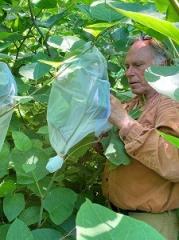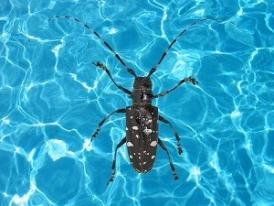NYSDEC News
Waterways, Boating, Invasive Knotweed, Beetles, Oak Wilt & Mystery Seeds!
Posted on: August 26, 2020 - 2:04pm
How's My Waterway
The U.S. Environmental Protection Agency (EPA) How's My Waterway (HMW) provides a comprehensive overview of water quality data and information in the United States on the community, state, and national scale. It includes swimming, fishing, aquatic life and water monitoring.
Visit: https://mywaterway.epa.gov/
Boat Responsibly - Clean. Drain. Dry. Every Time!
Y ou can help Protect Your Waters! One of the most effective ways we can all help stop the spread of aquatic invasive species is by following proper procedures for cleaning, draining, and drying watercraft and equipment every time you leave the water.
ou can help Protect Your Waters! One of the most effective ways we can all help stop the spread of aquatic invasive species is by following proper procedures for cleaning, draining, and drying watercraft and equipment every time you leave the water.
 ou can help Protect Your Waters! One of the most effective ways we can all help stop the spread of aquatic invasive species is by following proper procedures for cleaning, draining, and drying watercraft and equipment every time you leave the water.
ou can help Protect Your Waters! One of the most effective ways we can all help stop the spread of aquatic invasive species is by following proper procedures for cleaning, draining, and drying watercraft and equipment every time you leave the water. New York’s boat stewards are here to help. You’ll find them staffing launches and boat washing stations across the state. If you’re near a boat washing station, they offer a convenient way to make sure your watercraft is free of invasive species.
Find out more by watching our new video.
Aquatic invasive species can prevent us from enjoying our lakes and rivers and can even harm native fish populations. This summer and always, help us make sure they don’t stand a chance in New York. Can we count on you to Clean. Drain. Dry. every time? Learn more about aquatic invasive species and what else you can do to help prevent their spread on our website.
Biological Control for Japanese Knotweed Released in New York
 Japanese knotweeds (Reynoutria japonica, Reynoutria sachalinensis, and their hybrid Reynoutria X bohemica) are invasive plants that are infamously difficult to control and have negatively impacted ecosystems and economies in the US, Canada and Europe. For several years, researchers have sought to find a biocontrol for knotweed. Biocontrols are species selected from an invasive species’ native range that are used to control the invasive species in its introduced range. This approach is more targeted than chemical methods, and when successful, it permanently suppresses the invasive species.
Japanese knotweeds (Reynoutria japonica, Reynoutria sachalinensis, and their hybrid Reynoutria X bohemica) are invasive plants that are infamously difficult to control and have negatively impacted ecosystems and economies in the US, Canada and Europe. For several years, researchers have sought to find a biocontrol for knotweed. Biocontrols are species selected from an invasive species’ native range that are used to control the invasive species in its introduced range. This approach is more targeted than chemical methods, and when successful, it permanently suppresses the invasive species.After extensive testing and review by federal agencies, in March of this year, an insect native to Japan called the knotweed psyllid (Aphalara itadori) was approved for release in the United States as the country's first biocontrol agent for Japanese knotweed. This sap-sucking insect was released in New York State on June 10 by Dr. Bernd Blossey and colleagues from Cornell University. A week after releasing the 2,000 A. itadori adults at two locations in Tioga and Broome counties, the researchers found the insects had successfully laid eggs. The releases in NY are part of a nationwide effort with similar releases made in Rhode Island, Massachusetts, West Virginia, North Carolina, Oregon, and Washington State.
The Blossey Lab remains cautiously hopeful for success of A. itadori releases, however they will continue to explore additional safe, effective biocontrol organisms from Japan and China. This work in NY is led by Dr. Bernd Blossey in collaboration with the NY Invasive Species Research Institute, with funding from the Environmental Protection Fund as administered by DEC.
Photo of biocontrol release provided by Dr. Stacy Endriss
Help Look for Asian Longhorned Beetles
 Do you own a pool? You can help DEC look for the invasive Asian longhorned beetle (ALB) in New York! Through the rest of the summer, please check your pool filter for any insects that resemble ALB and report suspects by emailing photos to us at: foresthealth@dec.ny.gov.
Do you own a pool? You can help DEC look for the invasive Asian longhorned beetle (ALB) in New York! Through the rest of the summer, please check your pool filter for any insects that resemble ALB and report suspects by emailing photos to us at: foresthealth@dec.ny.gov.No pool? No problem - you can still help! Check your yard or neighborhood trees for signs of ALB, and let us know if you find anything suspicious.
Asian longhorned beetles are wood-boring beetles that attack a variety of our native hardwood trees, including maple, birch, willow, and others. In New York State, the insect is currently only known to be present in central Long Island. You can learn more about signs of ALB and the pool survey on our website.
Watch for Signs of Oak Wilt
July and August are the best months to spot signs of oak wilt. Oak wilt is a fungal disease that affects both red and white oaks, but red oaks often die much faster from the disease than white oaks. Oak wilt symptoms include:
- Most or all of the leaves fall off the tree in July/August
- Leaves brown from the outer edge back toward the stem
- Leaves of all colors will fall off, and many will still have green on them
- Dieback can be seen starting on the top of the tree and progressing downward
If you've seen these signs in an oak near you, email photos of the leaves, trunk, and entire tree to DEC at foresthealth@dec.ny.gov. Please include where the tree is located.
Want to help prevent the spread of this disease? It's easy! All you need to do is:
follow the NYS firewood regulation, and
if your oaks need pruning, plan to do it in winter when the insects that transport the disease are not active.
You can find more information on oak wilt on our website.
Mystery Seeds Making News
In the past few weeks, many New Yorkers have reported receiving unsolicited packages in the mail that contain plant seeds and appear to originate in China. Similar reports have been made in other states, and the US Department of Agriculture (USDA) is investigating.
If you receive unsolicited seeds, do not plant or handle them. View a recent statement from USDA and NYS Department of Agriculture and Markets on this topic, as well as details for what to do if you received seeds,

